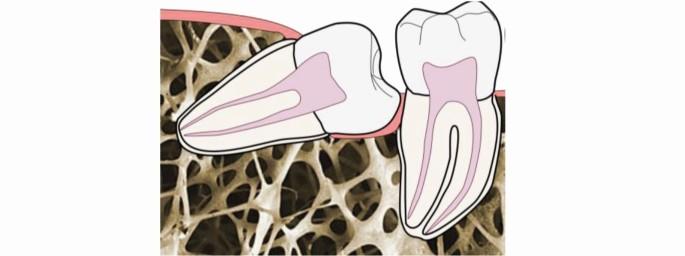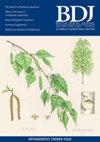水平和中角阻生下颌第三磨牙的患病率与年龄的关系
IF 2.3
4区 医学
Q2 DENTISTRY, ORAL SURGERY & MEDICINE
引用次数: 0
摘要
背景在过去的25年里,下颌阻生第三磨牙(M3Ms)的治疗一直是一个有争议的领域。本研究调查了水平和中角M3Ms患者样本中与年龄相关的疾病过程的患病率。方法记录400例患者下颌第二磨牙远端牙槽骨缺损(ABL)、牙袋深度(PPDs)及牙槽骨缺损(ABL)。结果536例M3M/M2M界面中,41% (n = 219)的M2M远端表面出现病变,11% (n = 61)的M2M病变严重,需切除。M3M龋的发生率为38.2% (n = 205);局部牙周炎,21.5% (n = 115);冠周炎,20.1% (n = 108);M2M龋占18.5% (n = 99)。年龄与病程数无简单相关性(r = -0.020; p = 0.648);M2M龋和冠周炎的患病率与年龄相关(2 = 9.951;p = 0.007; χ2 = 12.834; p = 0.002), PPD和ABL的患病率与年龄相关(p = 0.002本文章由计算机程序翻译,如有差异,请以英文原文为准。

Prevalence of disease associated with horizontal and mesioangular-impacted mandibular third molars in relation to age
Background The management of impacted mandibular third molars (M3Ms) has been an area of contention over the last 25 years. This study investigated the prevalence of disease processes in relation to age for a sample of patients with horizontal and mesioangular M3Ms. Method All concomitant disease processes including probing pocket depths (PPDs) and alveolar bone loss (ABL) distal to mandibular second molars (M2Ms) were recorded from a sample of 400 patients. Results From 536 M3M/M2M interfaces, 41% (n = 219) had a disease process present on the distal surface of the M2M and 11% (n = 61) had such significant disease that the M2M was removed. Presence of M3M caries was 38.2% (n = 205); localised periodontitis, 21.5% (n = 115); pericoronitis, 20.1% (n = 108); and M2M caries, 18.5% (n = 99). No simple correlation between age and number of disease processes was found (r = -0.020; p = 0.648); although, the prevalence of M2M caries and pericoronitis was related to age (χ2 = 9.951; p = 0.007 and χ2 = 12.834; p = 0.002), as was PPD and ABL (p <0.001). Conclusion(s) Multiple disease processes can occur concomitantly with horizontal or mesioangular M3Ms. Discussion of disease risk with regular clinical and intra-oral radiographic monitoring by general dental practitioners is recommended.
求助全文
通过发布文献求助,成功后即可免费获取论文全文。
去求助
来源期刊

British Dental Journal
医学-牙科与口腔外科
CiteScore
3.10
自引率
15.40%
发文量
1096
审稿时长
4-8 weeks
期刊介绍:
The role of the BDJ is to inform its readers of ideas, opinions, developments and key issues in dentistry - clinical, practical and scientific - stimulating interest, debate and discussion amongst dentists of all disciplines. All papers published in the BDJ are subject to rigorous peer review.
 求助内容:
求助内容: 应助结果提醒方式:
应助结果提醒方式:


